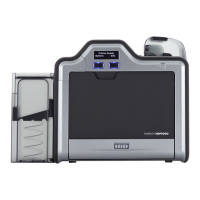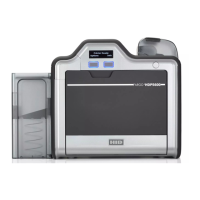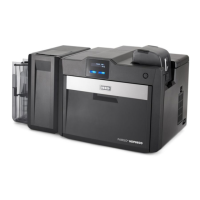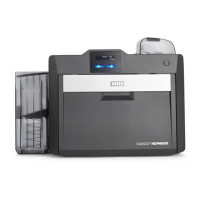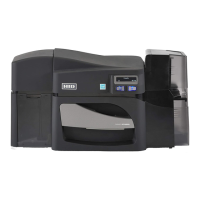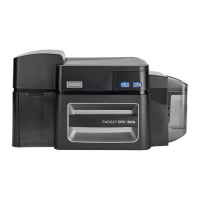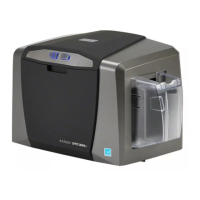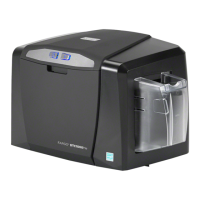Do you have a question about the HID HDPii and is the answer not in the manual?
Explains how to effectively use the HDPii User Guide for quick lookup of procedures and components.
Provides critical instructions and warnings for user safety during printer operation.
Details the step-by-step processes of the HDPii printer's boot-up sequence.
Describes the sequence of operations for a dual-sided, full color print job with magnetic encoding.
Details the technical specifications, including card dimensions, colors, interface, and memory.
Explains the operational principles of Dye-Sublimation and Resin Thermal Transfer technologies.
Describes the function and interaction of the printer's LCD display and softkey buttons.
Details the different types of print ribbons and their letter code designations.
Provides information on accepted card types, sizes, and recommended stock for printing.
Explains the function, controls, and temperature adjustment for the printer's transfer roller.
Provides critical safety instructions for performing printer installation procedures.
Details the items included with the printer and the initial inspection process.
Provides guidelines for selecting an optimal location for printer installation to ensure proper operation.
Guides through the procedure for installing the output module accessory.
Provides instructions for loading essential consumables like the print ribbon and transfer film.
Details the procedure for correctly loading blank cards into the printer's input cartridge.
Explains the correct procedure for connecting the printer to its power supply.
Outlines the steps required to install the HDPii printer driver, including security feature disabling.
Guides on how to print a test image to verify printer functionality after installation.
Provides critical safety instructions and warnings for handling printer accessories.
Explains how to use the printer's security lock slot for physical security.
Provides guidance on interpreting LCD messages and using troubleshooting tables.
Offers detailed tables for diagnosing and resolving LCD and printer error messages.
Details how to use the LCD error message table to identify and solve printer issues.
Details how to use the printer error message table to identify and solve printer issues.
Addresses common communication errors and provides procedures for resolving them.
Guides on printing a test image to diagnose printer functionality.
Explains how to use the alignment self-test card to check image placement.
Describes how to perform a magnetic self-test if the encoding module is installed.
Details the system requirements for using the printer's Ethernet option.
Outlines the features provided by the Fargo Ethernet option for printer management.
Provides an overview of network services offered by the Ethernet option.
Describes the HTTP service that provides a web interface for printer configuration.
Shows how to initiate a Telnet session to access printer services for administration.
Details standard procedures for using Ethernet web pages, including security and login.
Presents procedures for configuring network settings through the printer's web interface.
Guides on switching the printer's IP address configuration to automatic DHCP/BOOTP.
Details the procedure for changing the printer's IP address configuration to static.
Explains how to view information about the installed ribbon and film.
Describes how to view and change current system log settings for event logging.
Provides a procedure to enable logging notifications via email.
Details how to enable logging to a UDP Syslog program for event messages.
Guides on sending logging messages to a pre-existing IP connection via TCP port.
Explains how to use administration pages for upgrades, reboots, and password changes.
Details the process of uploading new firmware to the printer.
Provides critical safety instructions for performing printer adjustment procedures.
Guides on selecting the right cards and optimizing the HDP print process.
Details how to select appropriate printer driver settings based on card type.
Explains the procedure for installing new or updated printer driver versions.
Guides on setting up the printer driver with proper print options for Windows.
Explains how to use the Card tab to control specific printer functions.
Details how to select the appropriate card option for size settings.
Guides on selecting the appropriate card type based on card stock composition.
Explains how to set the card orientation to Portrait or Landscape.
Details how to specify the number of copies to be printed.
Describes how to launch the diagnostic tool from the printer preferences.
Explains how to print a test PRN file to verify printer and supply functionality.
Describes the use of the Device Options tab for consumables and dual-sided printing.
Guides on matching the ribbon type selection with the ribbon loaded in the printer.
Allows selection of the film type appropriate for the HDP film loaded in the printer.
Explains the functions of the Dual Sided group checkboxes for printing.
Explains how to adjust color properties like sharpness, contrast, and gamma.
Guides on selecting the appropriate dither method for resin printing.
Details how to use the advanced image color window for fine-tuning image properties.
Explains the use of slider controls for image quality adjustments like sharpness and contrast.
Allows adjustment of image position, transfer dwell time, and transfer temperature.
Guides on using image position controls to adjust image placement on the card.
Explains how to control image transfer speed and temperature for optimal results.
Details the procedure for conducting a tape adhesion test to evaluate print quality.
Provides options for controlling the magnetic stripe encoding process.
Guides on specifying coercivity and selecting magnetic tracks for encoding.
Explains how to customize character data size for magnetic data encoding.
Guides on customizing the character ASCII offset for magnetic data encoding.
Details how to customize the LRC Generation Mode for magnetic data encoding.
Explains how to customize the encoding mode for character parity.
Describes how magnetic track data is sent to the printer driver.
Provides a table of ASCII codes and their corresponding characters.
Allows adjustment of card size and print direction for the K panel resin.
Explains the use of scroll controls for adjusting image area size and location.
Option to print the resin black (K) panel for all black areas in the image.
Option to print resin black (K) panel for black found only in defined areas.
Option to print resin black (K) panel for black found outside defined areas.
Explains how to define areas on the card grid for image placement.
Guides on determining and measuring the total area to define on the card.
Details how to measure and position specific areas on the card.
Explains options for printing YMC under K or printing K only for resin black.
Allows viewing information about the installed ribbon and HDP film.
Guides on generating an Inhibit Panel Layout using the Fargo Workbench Utility.
Explains using application software with TextOut commands for inhibit area placement.
Describes the process of rendering print jobs for the printer, including bitmap file placement.
Details how the inhibit feature works and the two methods for defining inhibit areas.
Explains how to access the Toolbox window and its various tabs.
Guides on configuring printer features, event monitoring, and LCD language.
Describes the Event Monitoring group box for displaying low supplies messages.
Provides instructions for calibrating the film cartridge and settings.
Guides on calibrating the ribbon sensor and settings for optimal ribbon performance.
Explains how to access the Clean Printer tab for maintenance routines.
Details the functions of the Clean Printer group box for notifications and cleaning.
Explains how to adjust internal printer settings and restore default values.
Allows setting the overall darkness of the printed image by adjusting printhead heat.
Guides on adjusting the print top of form settings for proper image alignment.
Explains how to adjust print left of form settings for image alignment.
Guides on shifting the starting point for magnetic track data encoding.
Details how to set the printhead resistance value after replacement.
Provides instructions for adjusting the transfer time of flight (TOF) setting.
Covers settings for ribbon and film print take-up and supply tension.
Details settings for film supply and take-up transfer tension.
Provides adjustment for resin black text and barcodes appearing faded or too light/dark.
Adjusts the time until the printer conserves energy by de-energizing the transfer roller.
Adjusts the time until the printer enters a reduced transfer roller temperature mode.
Allows adjustment of the brightness of the printer's LCD panel.
Explains how to adjust the default number of passes for printer cleaning.
An ON/OFF switch to manage printer's environmental temperature compensation.
Controls the speed of the transfer roller cooling fan during printing.
Controls the default speed of the cooling fan for the transfer process.
Allows positioning of the Holographic film on the card.
Allows adjustment of voltage to the Mag Head for hi-co magnetic data.
Allows adjustment of the flipper angle when using the magnetic encoder.
Describes the error displayed when no printer is connected or communication fails.
Lists the essential supplies required for printer maintenance procedures.
Procedure to clean rollers to maintain print quality and prevent jams.
Guides on cleaning the interior of the printer using compressed air or cleaning pads.
Details the procedure for cleaning the printhead to maintain consistent print quality.
Instructions on how to replace the card cleaning roller.
Provides steps for cleaning the magnetic encoder in the output module.
Guides on replacing or cleaning the FAN foam filter for printer ventilation.
Explains how to access the Fargo Workbench Printer Utility via the Diagnostics button.
Provides information on printer firmware, its importance, and update procedures.
Details the procedure for upgrading the printer's main firmware using the utility.
Provides steps and contact information for obtaining technical support.
Explains how to find and interpret the printer's serial number for manufacturing details.
Explains how to effectively use the HDPii User Guide for quick lookup of procedures and components.
Provides critical instructions and warnings for user safety during printer operation.
Details the step-by-step processes of the HDPii printer's boot-up sequence.
Describes the sequence of operations for a dual-sided, full color print job with magnetic encoding.
Details the technical specifications, including card dimensions, colors, interface, and memory.
Explains the operational principles of Dye-Sublimation and Resin Thermal Transfer technologies.
Describes the function and interaction of the printer's LCD display and softkey buttons.
Details the different types of print ribbons and their letter code designations.
Provides information on accepted card types, sizes, and recommended stock for printing.
Explains the function, controls, and temperature adjustment for the printer's transfer roller.
Provides critical safety instructions for performing printer installation procedures.
Details the items included with the printer and the initial inspection process.
Provides guidelines for selecting an optimal location for printer installation to ensure proper operation.
Guides through the procedure for installing the output module accessory.
Provides instructions for loading essential consumables like the print ribbon and transfer film.
Details the procedure for correctly loading blank cards into the printer's input cartridge.
Explains the correct procedure for connecting the printer to its power supply.
Outlines the steps required to install the HDPii printer driver, including security feature disabling.
Guides on how to print a test image to verify printer functionality after installation.
Provides critical safety instructions and warnings for handling printer accessories.
Explains how to use the printer's security lock slot for physical security.
Provides guidance on interpreting LCD messages and using troubleshooting tables.
Offers detailed tables for diagnosing and resolving LCD and printer error messages.
Details how to use the LCD error message table to identify and solve printer issues.
Details how to use the printer error message table to identify and solve printer issues.
Addresses common communication errors and provides procedures for resolving them.
Guides on printing a test image to diagnose printer functionality.
Explains how to use the alignment self-test card to check image placement.
Describes how to perform a magnetic self-test if the encoding module is installed.
Details the system requirements for using the printer's Ethernet option.
Outlines the features provided by the Fargo Ethernet option for printer management.
Provides an overview of network services offered by the Ethernet option.
Describes the HTTP service that provides a web interface for printer configuration.
Shows how to initiate a Telnet session to access printer services for administration.
Details standard procedures for using Ethernet web pages, including security and login.
Presents procedures for configuring network settings through the printer's web interface.
Guides on switching the printer's IP address configuration to automatic DHCP/BOOTP.
Details the procedure for changing the printer's IP address configuration to static.
Explains how to view information about the installed ribbon and film.
Describes how to view and change current system log settings for event logging.
Provides a procedure to enable logging notifications via email.
Details how to enable logging to a UDP Syslog program for event messages.
Guides on sending logging messages to a pre-existing IP connection via TCP port.
Explains how to use administration pages for upgrades, reboots, and password changes.
Details the process of uploading new firmware to the printer.
Provides critical safety instructions for performing printer adjustment procedures.
Guides on selecting the right cards and optimizing the HDP print process.
Details how to select appropriate printer driver settings based on card type.
Explains the procedure for installing new or updated printer driver versions.
Guides on setting up the printer driver with proper print options for Windows.
Explains how to use the Card tab to control specific printer functions.
Details how to select the appropriate card option for size settings.
Guides on selecting the appropriate card type based on card stock composition.
Explains how to set the card orientation to Portrait or Landscape.
Details how to specify the number of copies to be printed.
Describes how to launch the diagnostic tool from the printer preferences.
Explains how to print a test PRN file to verify printer and supply functionality.
Describes the use of the Device Options tab for consumables and dual-sided printing.
Guides on matching the ribbon type selection with the ribbon loaded in the printer.
Allows selection of the film type appropriate for the HDP film loaded in the printer.
Explains the functions of the Dual Sided group checkboxes for printing.
Explains how to adjust color properties like sharpness, contrast, and gamma.
Guides on selecting the appropriate dither method for resin printing.
Details how to use the advanced image color window for fine-tuning image properties.
Explains the use of slider controls for image quality adjustments like sharpness and contrast.
Allows adjustment of image position, transfer dwell time, and transfer temperature.
Guides on using image position controls to adjust image placement on the card.
Explains how to control image transfer speed and temperature for optimal results.
Details the procedure for conducting a tape adhesion test to evaluate print quality.
Provides options for controlling the magnetic stripe encoding process.
Guides on specifying coercivity and selecting magnetic tracks for encoding.
Explains how to customize character data size for magnetic data encoding.
Guides on customizing the character ASCII offset for magnetic data encoding.
Details how to customize the LRC Generation Mode for magnetic data encoding.
Explains how to customize the encoding mode for character parity.
Describes how magnetic track data is sent to the printer driver.
Provides a table of ASCII codes and their corresponding characters.
Allows adjustment of card size and print direction for the K panel resin.
Explains the use of scroll controls for adjusting image area size and location.
Option to print the resin black (K) panel for all black areas in the image.
Option to print resin black (K) panel for black found only in defined areas.
Option to print resin black (K) panel for black found outside defined areas.
Explains how to define areas on the card grid for image placement.
Guides on determining and measuring the total area to define on the card.
Details how to measure and position specific areas on the card.
Explains options for printing YMC under K or printing K only for resin black.
Allows viewing information about the installed ribbon and HDP film.
Guides on generating an Inhibit Panel Layout using the Fargo Workbench Utility.
Explains using application software with TextOut commands for inhibit area placement.
Describes the process of rendering print jobs for the printer, including bitmap file placement.
Details how the inhibit feature works and the two methods for defining inhibit areas.
Explains how to access the Toolbox window and its various tabs.
Guides on configuring printer features, event monitoring, and LCD language.
Describes the Event Monitoring group box for displaying low supplies messages.
Provides instructions for calibrating the film cartridge and settings.
Guides on calibrating the ribbon sensor and settings for optimal ribbon performance.
Explains how to access the Clean Printer tab for maintenance routines.
Details the functions of the Clean Printer group box for notifications and cleaning.
Explains how to adjust internal printer settings and restore default values.
Allows setting the overall darkness of the printed image by adjusting printhead heat.
Guides on adjusting the print top of form settings for proper image alignment.
Explains how to adjust print left of form settings for image alignment.
Guides on shifting the starting point for magnetic track data encoding.
Details how to set the printhead resistance value after replacement.
Provides instructions for adjusting the transfer time of flight (TOF) setting.
Covers settings for ribbon and film print take-up and supply tension.
Details settings for film supply and take-up transfer tension.
Provides adjustment for resin black text and barcodes appearing faded or too light/dark.
Adjusts the time until the printer conserves energy by de-energizing the transfer roller.
Adjusts the time until the printer enters a reduced transfer roller temperature mode.
Allows adjustment of the brightness of the printer's LCD panel.
Explains how to adjust the default number of passes for printer cleaning.
An ON/OFF switch to manage printer's environmental temperature compensation.
Controls the speed of the transfer roller cooling fan during printing.
Controls the default speed of the cooling fan for the transfer process.
Allows positioning of the Holographic film on the card.
Allows adjustment of voltage to the Mag Head for hi-co magnetic data.
Allows adjustment of the flipper angle when using the magnetic encoder.
Describes the error displayed when no printer is connected or communication fails.
Lists the essential supplies required for printer maintenance procedures.
Procedure to clean rollers to maintain print quality and prevent jams.
Guides on cleaning the interior of the printer using compressed air or cleaning pads.
Details the procedure for cleaning the printhead to maintain consistent print quality.
Instructions on how to replace the card cleaning roller.
Provides steps for cleaning the magnetic encoder in the output module.
Guides on replacing or cleaning the FAN foam filter for printer ventilation.
Explains how to access the Fargo Workbench Printer Utility via the Diagnostics button.
Provides information on printer firmware, its importance, and update procedures.
Details the procedure for upgrading the printer's main firmware using the utility.
Provides steps and contact information for obtaining technical support.
Explains how to find and interpret the printer's serial number for manufacturing details.


